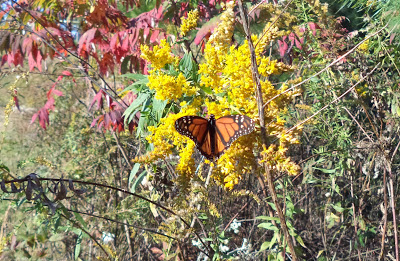

| Visitors Now: | |
| Total Visits: | |
| Total Stories: |
Where the Pollinators and Predators Hang Out
The picture below isn’t from my yard. Joe and I walked around our local park last Saturday, and there were butterflies, bees, wasps, and other great insects on all the flowering weeds.
 |
| Not my yard, but great to see a Monarch butterfly near home |
It made me wonder how much my own garden’s success depends on the city’s not mowing edge-to-edge in my local parks.
When food gardens have a problem with low productivity, it sometimes can be traced to a scarcity of pollinators. A lot of newer neighborhoods are border-to-border monoculture lawns. These yards are pretty low on habitat that would support useful populations of pollinators and other beneficial insects.
Most gardeners understand that this is a problem, and they follow guidelines like those in UGA’s publication Beyond Butterflies: Gardening for Native Pollinators to plant small-flowered herbs and other pollen-and nectar-rich flowers that attract pollinators and useful predators, but if the insects don’t have a good place to reproduce and to survive the winter, there might never be an abundance of these useful critters.
My garden crops typically don’t have a problem with lack of pollination, and there seem to be plenty of great predatory insects, too, but, like all those other gardeners, I do what I can to attract a diverse community of insects and other small creatures to my own yard. Also, I am lucky in that my yard backs up to a small patch of woods and that it has a creek — with associated native vegetation — running along one side. I am sure that all helps.
According to a recent article posted at Southern Region IPM News, The Right Habitat and Food Source Key for Beneficial Insects, that describes findings of entomologists at North Carolina State University, the parasitic wasp Telemonus podisi (it kills stink bug embryos) overwinters more often in leaf litter than in cracks of tree bark:
“The number of parasitic wasps, for example, was four times greater in leaf litter than those overwintering in tree bark,” said Lahiri. “This data, combined with lab studies, suggest the importance of woodland field borders with leaf litter from hardwood trees as a refuge area during winter for the parasitoids.”
I do have some woodland edge, but — even combined with the right garden flowers — the wild spaces in my one yard may not be enough to support all the beneficial insects that help out in my garden.
Wouldn’t it be something if the unmowed and uncleared edges of city and county parks were the best refuges for our beneficial insect populations?
Source: http://atlantaveggies.blogspot.com/2013/11/where-pollinators-and-predators-hang-out.html



